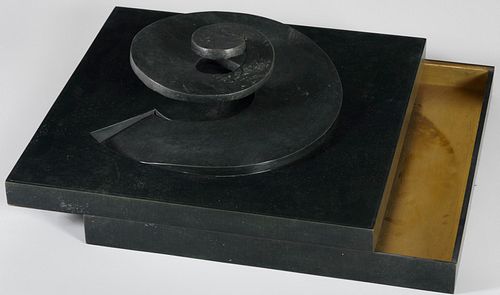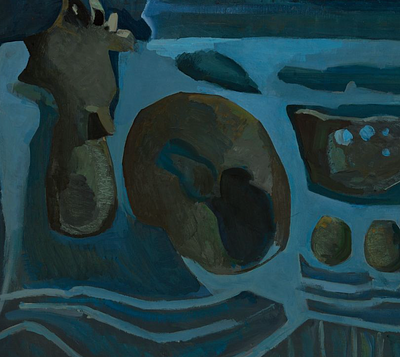MARTÍN CHIRINO LÓPEZ (Las Palmas de Gran Canaria, 1925). "The spiral wind of the rose", 2006. Bronze. Exemplary 12/75.
Lot 91
About Seller
Setdart Auction House
Carrer Aragó 346
Barcelona
Spain
Setdart Subastas was born in 2004 and is currently the first online art auction in Spain with solidity, prestige and reliability guaranteed by our more than 60,000 users. Setdart has a young, dynamic and enterprising team ready to successfully manage the purchase and sale of art works through custom...Read more
Categories
Estimate:
EUR€6,000 - EUR€8,000
$6,451.61 - $8,602.15
Absentee vs Live bid
Two ways to bid:
- Leave a max absentee bid and the platform will bid on your behalf up to your maximum bid during the live auction.
- Bid live during the auction and your bids will be submitted real-time to the auctioneer.
Bid Increments
| Price | Bid Increment |
|---|---|
| EUR€0 | EUR€10 |
| EUR€200 | EUR€25 |
| EUR€500 | EUR€50 |
| EUR€1,000 | EUR€100 |
| EUR€3,000 | EUR€200 |
| EUR€5,000 | EUR€500 |
| EUR€10,000 | EUR€1,000 |
| EUR€20,000 | EUR€2,000 |
| EUR€50,000 | EUR€5,000 |
About Auction
By Setdart Auction House
Jul 27, 2021
Set Reminder
2021-07-27 08:00:00
2021-07-27 08:00:00
America/New_York
Bidsquare
Bidsquare : CONTEMPORARY AND ACTUAL ART
https://www.bidsquare.com/auctions/setdart-auction-house/contemporary-and-actual-art-7261
Setdart Auction House sofia@setdart.com
Setdart Auction House sofia@setdart.com
- Lot Description
MARTÍN CHIRINO LÓPEZ (Las Palmas de Gran Canaria, 1925). "The spiral wind of the rose", 2006. Bronze. Exemplary 12/75. Signed and dated. Work reproduced in the catalog raisonné of the artist. p.444. Measures: 25 x 60 x 60 cm. Sculpture of round bulk whose form recalls the abstraction in an organic way. Being a piece that despite the rigidity of the material, it seems ductile. The sculptor has managed to capture the movement through the twisting of the bronze, which forms different waves of volumetric character. However, this spiral that iconographically represents the wind is supported by a base whose volume of straight and rounded lines creates a dialectic play of the forms that make up the sculptural ensemble. The sculptor Martín Chirino developed his training at the San Fernando School in Madrid and at the School of Fine Arts in London. After a first sculptural series "Reinas Negras" (Black Queens), and exhibitions such as the group show at the Museo Canario, Chirino moved to Madrid in 1955, accompanied by his friends Manolo Millares, Elvireta Escobio, Manuel Padrono and Alejandro Reino. He also spent a month in London, where he got to know first-hand the Sumerian and Egyptian sculptures in the British Museum. Only one year later, in 1956, the Museo de Arte Contemporáneo de Madrid acquired two of his works. He then held his first solo exhibition at the Ateneo de Madrid, after which he became a member of the recently founded El Paso group. His recognition grew, and only two years later he was given a special room in the Spanish pavilion at the São Paulo Biennial. In 1960 he took part in a group exhibition at the MOMA in New York, where he presented four pieces, one of which already featured the spiral, the most recurrent theme in his work since those years. The gallerist Grace Borgenicht, impressed by these four pieces, made a trip to Madrid to hire Chirino exclusively for the United States, a contract that remained in force until Borgenicht's death in 1994. Since his participation in the MOMA collective, and after the dissolution of El Paso in 1960, Chirino developed his solo career and showed his work all over the world, an abstract production characterized by the lack of narrative elements and by formal and symbolic richness. He is currently represented in museums all over the world, including the Guggenheim in New York, the MACBA in Barcelona, the Juan March Foundation, the Smithsonian Institution in Washington, the Museo de Bellas Artes in Caracas, etc.
- Shipping Info
-
In-house shipping available. Please inquire at admin@setdart.com.
-
- Buyer's Premium



 EUR
EUR CAD
CAD AUD
AUD GBP
GBP MXN
MXN HKD
HKD CNY
CNY MYR
MYR SEK
SEK SGD
SGD CHF
CHF THB
THB












